Your brushes are an investment. By cleaning them thoroughly and properly at the end of a painting session, they will last longer.
Here’s How:
- Wipe off any excess paint using a cloth or soft tissue. Gently squeezing the bristles from the ferrule edge outwards with your fingers, or with a cloth, will help remove paint from the brush. But be careful to avoid pulling on the bristles.
- Rinse the brush in turpentine or oil if you’ve been using oils or lukewarm water if you’ve been using a water-based medium. Never use hot water as it can expand the ferrule, causing the hairs to fall out.
- Wipe it on the cloth again to remove the last of the excess paint.
- Wash gently using a little bit of mild soap (or a gentle dishwashing liquid). Dab the brush gently onto the piece of soap, then work up a lather in a small container (or the palm of your hand if you’re not using any toxic pigments or solvents).
- Rinse and repeat until there’s no trace of any color coming out. Over time a brush may become stained, but don’t stop rinsing until you’re sure there’s no paint left.
- Rinse once more in clean, lukewarm water to remove any traces of soap. Shake off the water.
- Use your fingers to gently shape the brush head into its correct shape.
- If necessary, wrap the bristles in a piece of tissue or toilet paper while the brush is still wet. When the paper dries it’ll contract, pulling the bristles into shape.
- Leave brush to dry at room temperature. Ensure it’s not resting on its head as it will then dry misshapen. Standing it on the back of the handle works well.
- If you’re worried about the toxicity of the paint you’re working with, wear gloves while painting and cleaning your brushes. Also if you find the paint is drying out and cracking, or staining your skin.
Tips:
- Always use separate brushes for oil painting and water-based medium. After all, oil repels water. Also use separate brushes for varnish, gesso, and masking fluid.
- Don’t let acrylic paint dry on a brush as its water-resistant when dry. But also never leave a brush standing in water.
- Never use a lot of pressure to force paint out of a brush. Be patient and rinse it several times.
- If your brush is made from natural bristle, you can soften it by dipping it in clean oil (the one you use as a medium) after you have cleaned it.
- Misshapen synthetic brushes can sometimes be reshaped by soaking them in hot water (not boiling).
What You Need
- Luke-warm water
- Mild soap
- Patience

Leave a Reply
You must be logged in to post a comment.